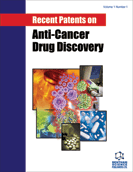
Abstract
Lung cancer is the leading cause of malignancy-related mortality worldwide. Metastases, which account for 90% of lung cancer deaths, frequently target the skeleton, leading to rapid deterioration in quality of life and premature death. The molecular mechanism underlying this progression, especially the development of bone metastases, is largely unknown. MicroRNAs (miRNAs) are small, endogenous, noncoding RNAs that function as negatively posttranscriptional gene regulators. Changes in miRNAs, which may exhibit either oncogenic or tumor suppressive activity, are common in lung cancer. Over-expressed miRNAs may contribute to oncogenesis by down-regulating tumor suppressors, whereas the loss of selected miRNAs may negatively regulate oncogenes or factors related to tumorigenesis and progression. MiRNAs may activate or repress metastases. Specific miRNA expression profiles may correlate with the response in treatment. We summarize recent findings and patents in the pathological roles of miRNAs in the progression and bone metastases in lung cancer, and discuss the diagnostic and therapeutic options in the clinical management of lung cancer.
Keywords: Biomarker, bone metastases, lung cancer, miRNA, oncogenesis, squamous cell carcinoma.
Recent Patents on Anti-Cancer Drug Discovery
Title:MicroRNAs in Lung Cancer and Lung Cancer Bone Metastases: Biomarkers for Early Diagnosis and Targets for Treatment
Volume: 10 Issue: 2
Author(s): Qian Zhao, Ping Li, Junrong Ma and Xijie Yu
Affiliation:
Keywords: Biomarker, bone metastases, lung cancer, miRNA, oncogenesis, squamous cell carcinoma.
Abstract: Lung cancer is the leading cause of malignancy-related mortality worldwide. Metastases, which account for 90% of lung cancer deaths, frequently target the skeleton, leading to rapid deterioration in quality of life and premature death. The molecular mechanism underlying this progression, especially the development of bone metastases, is largely unknown. MicroRNAs (miRNAs) are small, endogenous, noncoding RNAs that function as negatively posttranscriptional gene regulators. Changes in miRNAs, which may exhibit either oncogenic or tumor suppressive activity, are common in lung cancer. Over-expressed miRNAs may contribute to oncogenesis by down-regulating tumor suppressors, whereas the loss of selected miRNAs may negatively regulate oncogenes or factors related to tumorigenesis and progression. MiRNAs may activate or repress metastases. Specific miRNA expression profiles may correlate with the response in treatment. We summarize recent findings and patents in the pathological roles of miRNAs in the progression and bone metastases in lung cancer, and discuss the diagnostic and therapeutic options in the clinical management of lung cancer.
Export Options
About this article
Cite this article as:
Zhao Qian, Li Ping, Ma Junrong and Yu Xijie, MicroRNAs in Lung Cancer and Lung Cancer Bone Metastases: Biomarkers for Early Diagnosis and Targets for Treatment, Recent Patents on Anti-Cancer Drug Discovery 2015; 10 (2) . https://dx.doi.org/10.2174/1574892810666150120163617
| DOI https://dx.doi.org/10.2174/1574892810666150120163617 |
Print ISSN 1574-8928 |
| Publisher Name Bentham Science Publisher |
Online ISSN 2212-3970 |
 63
63 1
1
- Author Guidelines
- Graphical Abstracts
- Fabricating and Stating False Information
- Research Misconduct
- Post Publication Discussions and Corrections
- Publishing Ethics and Rectitude
- Increase Visibility of Your Article
- Archiving Policies
- Peer Review Workflow
- Order Your Article Before Print
- Promote Your Article
- Manuscript Transfer Facility
- Editorial Policies
- Allegations from Whistleblowers
Related Articles
-
Small Molecular Inhibitors Targeting Chromatin Regulating Proteins for Cancer
Current Protein & Peptide Science TGF-β1 Causes EMT by Regulating N-Acetyl Glucosaminyl Transferases via Downregulation of Non Muscle Myosin II-A through JNK/P38/PI3K Pathway in Lung Cancer
Current Cancer Drug Targets High Diagnostic and Prognostic Value of miRNAs Compared with the Carcinoembryonic Antigen As A Traditional Tumor Marker
Anti-Cancer Agents in Medicinal Chemistry Modulation of Ornithine Decarboxylase Activity by Phenolics Based Structurally Related Compounds Synthesized on Steroidal and Non-Steroidal Skeleton and their Radical Scavenging Action
Current Bioactive Compounds From Biology to Therapy: Improvements of Therapeutic Options in Lung Cancer
Anti-Cancer Agents in Medicinal Chemistry <i>Anastatica hierochuntica </i>Extracts: Promising, Safe and Selective Anticancer Agents
The Natural Products Journal Recent Advances in the Identification of Genetic and Biochemical Components of Breast Cancer Predisposition
Current Genomics Redox-active and Redox-silent Compounds: Synergistic Therapeutics in Cancer
Current Medicinal Chemistry Multimodal Imaging for the Diagnosis of Massive Left Atrial Metastasis from Lung Cancer - A Case Report
Current Medical Imaging Recent Developments in the Field of Anticancer Platinum Complexes
Recent Patents on Anti-Cancer Drug Discovery Perspectives Offered by Single-Domain Antibodies in Clinical Diagnostic of Pediatric Tumors
Current Medicinal Chemistry microRNAs Downregulation in Cancer is Associated with Guanine Enrichment in the Terminal Loop Sequences of their Precursors
MicroRNA Progress in Research of K<sub>V</sub>1.1 and K<sub>V</sub>1.3 Channels as Therapeutic Targets
Current Topics in Medicinal Chemistry Anti-miRNA-23a Oligonucleotide Suppresses Glioma Cells Growth by Targeting Apoptotic Protease Activating Factor-1
Current Pharmaceutical Design Cigarette Smoke-mediated Perturbations of the Immune Response: A New Therapeutic Approach with Natural Compounds
Endocrine, Metabolic & Immune Disorders - Drug Targets RAGE: A Multi-Ligand Receptor Unveiling Novel Insights in Health and Disease
Current Medicinal Chemistry Use of Positron Emission Tomography for Target Volume Definition
Current Radiopharmaceuticals Red Blood Cell-Encapsulated L-Asparaginase: Potential Therapy of Patients with Asparagine Synthetase Deficient Acute Myeloid Leukemia
Protein & Peptide Letters Targeting Aurora Kinases: A Novel Approach to Curb the Growth & Chemoresistance of Androgen Refractory Prostate Cancer
Current Cancer Drug Targets Structural and Computational Biology of the Molecular Chaperone Hsp90: From Understanding Molecular Mechanisms to Computer-Based Inhibitor Design
Current Topics in Medicinal Chemistry


























